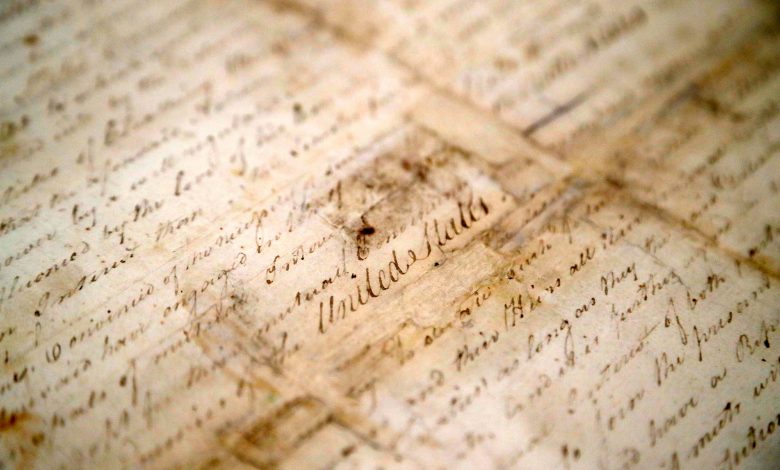1778 Treaty of Fort Pitt: US treaty with the Lenape Nation

During the Revolutionary War, one of the United States’ earliest treaties with the nation of Lenape, Delaware aimed at building an alliance against the British was the Treaty of Fort Pitt. Why was this treaty different from the French alliance earlier this year? And why did it break so quickly?
Crossing the Lenape Territory during the Revolutionary War
European countries made contact with the Lenape nation in the 17th century and negotiated treaties and trade agreements. This 1766 English drawing, “A Delaware Indian. with his tomohawk [sic] Scalping Knife, &c.” represents the stereotypical white European propaganda that Native Americans posed a threat to Europe’s colonization of North America. Courtesy of the JCB Archive of Early American Images.
In 1778, after news came from France that the Treaty of Friendship and Trade and the Treaty of Confederation had been completed, the Continental Army planned to march its forces west and attack the British at Detroit. But the route traversed the Lenape Territory in the Ohio Valley.
The United States appointed brothers Andrew and Thomas Lewis as official diplomats to obtain permission for the Lenape to transit their country. Congress approved $10,000 in goods and gifts given to Lenape leaders to show US goodwill.
The contracting process
In September, US diplomats met with Koquethagechton (White Eyes), Gelemend (John Killbuck, Jr.), and Konieschquanoheel or Hopocan (Captain Pipe) at Fort Pitt in western Pennsylvania to begin negotiations.
No one is sure what language the Lenape and Americans spoke during the negotiations, but it was most likely a mixture of Algonquian dialects and English. But both communicated through the diplomatic means established between native nations and European nations when the American colonies were part of the British Empire.
American diplomats hailed their counterparts in Lenape as “brothers” and “chiefs and sages of the Delaware nation.” They explained why they had sought the negotiations, acknowledging that “the chain of friendship” (between the Americans and the British) “had contracted some rust of a very dangerous nature” and required Lenape’s assistance.
The Lenape presented the Lewis brothers with a belt of white wampum, in black, the 13 United States and the Lenape Nation in a visual chain of the Alliance. Wampum belts were a symbolic instrument of contract making in some native nations, showing parties in a kinship relationship.

The Lenape Nation presented this 1680s wampum belt to William Penn, the English founder of Pennsylvania, as part of a land sale or treaty. The 1778 wampum belt presented by the Lenape to the Lewis brothers was made of similar materials and intended to convey a kinship link between the parties. Courtesy of the National Museum of the American Indian.
The Americans also announced the recent alliance with France and offered to extend this “bright and comprehensive chain” of “friendship and support” to the Lenape nation. The Lenape had an alliance with the French and interpreted this announcement as an extension of existing Native American and European kinship networks that had been cultivated for centuries.
The negotiations lasted several days. On September 17, 1778, they signed a treaty called the Treaty of Fort Pitt, which promised an “eternal peace and friendship” between the two nations.
In the text of the signed treaty, the Lenape agreed to allow the Continental Army to cross their country, lead them to British locations and “join the United States troops”.
In return, the Americans promised to build a fortress in the Lenape territory for protection and promised trade goods. In addition, the treaty provided for the creation of a 14th Indian-governed state with a political representative in the US Congress.

1781 French topographic map showing the strategic importance of Fort Pitt to United States military advances during the Revolution and its aggressive push into Native American territory thereafter. Courtesy of George Washington’s Mount Vernon.
The Fort Pitt Treaty quickly collapses
Like Franklin’s negotiations with the French, American diplomacy with the Lenape leaders was conducted with mutual respect and discussions of each nation’s self-interest. In both cases, the contracting involved diplomacy using traditional norms. However, unlike the French alliance, which lasted beyond the end of the American Revolution, the Treaty of Fort Pitt began to crumble within weeks.
First the Lenape leader White Eyes died. While American officials insisted White Eyes died from smallpox as the cause, evidence suggested members of the militia had murdered him, and the circumstances remain unclear to this day. This act showed the Lenape that Americans neither valued nor honored the importance of kinship bonds.
Second, Americans lacked cultural awareness when dealing with the Lenape. For the United States, a signed paper treaty made the terms of the agreement final and terminated the treaty. This is how the Americans and the French understood each other after they signed their alliance. But for the Lenape, the relationship built during the negotiations was dynamic and needed nurturing to continue the alliance. The paper contract represented the beginnings of the relationship, not the end.

1779 sketch showing Morgan’s farm in Princeton, NJ. Colonel George Morgan (1743-1810), a US representative on Indian affairs during the Revolution (1776-1779), had gained the trust of the Lenape, who named him “Tamanend” in honor of one of their lost warriors. He was a trusted translator between the Lenape and the Americans, but was notably absent from the September negotiations at Fort Pitt. After the treaty was signed, Morgan encouraged the Lenape to challenge its terms, telling them they had been deceived in the negotiations and “to protest this misinterpretation with a spirit that will become the wise Delaware nation.” In 1779, Morgan accompanied the Lenape delegation to the US Congress in Philadelphia when they called on the United States to respect its sovereignty and right to neutrality. To Morgan’s disappointment, Congress replied that the United States was not bound by any agreements as long as any Lenape warriors would help the British. Morgan immediately resigned from his position. He also later wrote to Congress to counter the official narrative that White Eyes died of smallpox. Photo courtesy of Princeton University.
Above all, the Americans did not keep their treaty promises. The merchandise never arrived. The US Congress has never discussed the creation of a sovereign 14th Native American state. The United States hastily built a fort in the Lenape Territory, Fort Laurens, but the British quickly took it over. The US government also failed to prevent white Americans from occupying Lenape lands.
The Lenape attempt to save the contract
The Lenape initially attempted to salvage their alliance with the United States.
First, a Lenape delegation went to the Continental Congress and asked them to keep their promises. In addition, some Lenape warriors supported the Continental Army, but after it became clear that the alliance was broken, more Lenape joined the British against the Americans. The United States used this as an excuse to state that the Lenape had broken the terms of the treaty and made no diplomatic attempts to mend the relationship.
In 1782, a Pennsylvania militia massacred a peaceful Lenape Christian community in Gnadenhutten. Many left the Ohio Valley afterwards. Their Lenape descendants later founded the Delaware nation in Moraviantown, Ontario, the Delaware tribe of Native Americans in northeastern Oklahoma, and the Delaware nation in central Oklahoma.

Ohio historical marker noting the 1782 massacre of Christian Lenape, who had joined the Moravian Church. The brutal attack further fueled violence between white Americans and Native Americans as Shawnees and Wyandot joined the Lenape in trying to defend their people and their land. Courtesy of the Historical Marker Database.
Anti-Lenape violence, a lack of cultural awareness, and poor diplomatic communications were just some of the problems that led to the failure of the Fort Pitt Treaty. Similar issues persisted for years between the United States and sovereign Native Americans.
The National Museum of American Diplomacy thanks Dr. Margaret Ball, historian at the Office of the Historian, US Department of State, for her thoughtful contributions to this blog.
Sources and further reading
Colin G Galloway, The American Revolution in Indian County: Crisis and Diversity in Native Communities (Cambridge Studies in North American Indian History, New York: Cambridge University Press, 1995).
Congress, United States Continental, Worthington Chauncey 1858-1941[FordandGaillard1862-1924Hunt[FordandGaillard1862-1924Hunt[FordundGaillard1862-1924Hunt[FordandGaillard1862-1924HuntJournals of the Continental Congress, 1774-1789; Volume 9. Biblio Bazaar, 2016).
Brian Delay, “Indian Polities, Empire, and the History of American Foreign Relations”, in diplomatic history 39, No. 5 (November 2015): 927-42.
Gregory Evans Dowd, A Spirited Resistance: The North American Indian Struggle for Unity, 1745-1815 (Baltimore: Johns Hopkins University Press, 1993).
Randolph Chandler Downes, Council Fires on the Upper Ohio: A Narrative of Indian Affairs in the Upper Ohio Valley to 1795 (Pittsburgh: University of Pittsburgh Press, 1969).
Richard S Grimes, The Western Delaware Indian Nations, 1730-1795: Warriors and Diplomats (Rowman & Littlefield, 2017).
Suzan Shown Harjo (ed.), Nation to Nation: Treaties Between the United States and Native American Nations (Washington, DC: Smithsonian Institution, 2014).
Dorothy V Jones, License to Empire: Colonialism by Treaty in Early America (Chicago: University of Chicago, 1982).
Franz Paul Prucha, Indian Treaties: The Story of a Political Anomaly (Berkeley, CA: University of California Press, 1994).
Otis K Reis, The Allegheny Frontier: West Virginia Beginnings, 1730-1830 (Lexington: University Press of Kentucky, 2021).
Amy C Schuett, Peoples of the River Valleys: The Odyssey of the Delaware Indians (Philadelphia: University of Pennsylvania Press, 2007).
Eric Sterner, The Treaty of Fort Pitt: The First US-American Indian Treaty, in Journal of the American Revolution
richard white, The Middle Ground: Indians, Empires, and Republics in the Great Lakes Region, 1650-1815 (New York: Cambridge University Press, 2006)
Museum of the American Revolution
National Museum of the American Indians



